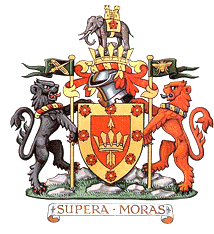Bolton Research
Researching your Bolton Family History

The Metropolitan Borough of Bolton was formed on 1st April 1974 , by the merger of the county borough of Bolton and the following districts, Blackrod; Farnworth; Horwich; Kearsley; Little Lever; Turton and Westhoughton.
Bolton has a long and varied history and was granted its first Royal Charter in 1251 which permitted a market to be held in Churchgate. By the time of the Civil War the population was about 12,000 but in the Bolton Massacre of 1644 about 1500 of the Parliamentary defenders were killed by the besieging Royalist forces. The town took its revenge on the 15th October 1651 when the Royalist Earl of Derby, who had been held responsible for the Massacre, was beheaded in Churchgate, having spent his last hours in The Man & Scythe pub, which is still there and still serving beer.
Historically the principal employment has been cotton spinning and engineering, often associated with the cotton industry. In the 20th century the Atlas Mills complex of 8 mills had more than 750,000 spindles at work but the 19th century conversion of the cotton industry from a home based to a factory system was not without its problems thus in Westhoughton in 1812 one of the new factories was burnt to the ground by Luddites. It was here in Bolton in 1779 that local man, Samuel Crompton, developed the Spinning Mule which was a dramatic improvement on previous machinery and hastened the conversion to the factory system.
Horwich was home to the Horwich Railway Workshops of the Lancashire & Yorkshire Railway. This was a massive undertaking where famous railway engineers like Nigel Gresley, Henry Fowler and Richard Maunsell learnt their trade.
Farnworth was one of the principal sources of coal in the area and some of its mines were connected by an underground canal system that emerged at The Delph, Worsley to join the Bridgewater Canal.
The Westhoughton Pretoria Pit Disaster which occurred on the 21 December 1910 took the lives of 344 men and boys.
Bolton Churches
The Parish Church of St Peter, Bolton-le-Moors is believed to have Saxon origins with the present building dating from 1871. Parts of a Saxon cross can be seen inside the church. The size of the parish resulted in Chapels of Ease being created at Blackrod, Bradshaw, Rivington, Walmsley and Turton. The available parish records start from 1573. As it stands today St Mary the Virgin, Deane, commonly called Deane Church, dates from about 1452, and it too had Chapelries serving Horwich, Little Hulton [Peel] and Westhoughton. Its available records start from 1604.
SS Peter & Paul was the first post-reformation Roman Catholic church and has records available from 1794 whilst Bank Street Unitarian Church records start from 1753. Bolton was once called The Geneva of the North, such was the strength of Non-Conformity in the area. At different times the town has also had a number of different churches including a Scottish Chapel, Baptists, the Society of Friends, Swedenborgians, Methodists, a French Chapel and Wesleyans.
Bolton Birth, Marriages, Deaths and Burials
Details of all the Bolton marriages, including the Registrar recorded ones, from the 1st July 1837 to the 31st December 1992 are available on Lancashire BMD and details from the birth and death registers are in the process of being added. Check the website for current coverage.
Astley Bridge cemetery opened 1884, Blackrod 1887, Farnworth 1876, Heaton 1879, Horwich [Ridgemont] 1928, Tonge [Bolton] 1856, Westhoughton 1858 and Overdale Crematorium 1954. Bolton MBC have added 415,000 burial records to Deceased Online but many of the details are freely available on film at Bolton History Centre. Memorial Inscriptions for 20 Bolton Churchyards are available to Society members in the members area of the MLFHS website.
Lancashire Online Parish Clerk
Lancashire OPC is an important resource for anybody researching in the Bolton area. Many of the records include information well beyond the basic church register details.
Workhouses
Bolton and district have had several workhouses but researchers should remember that the Fishpool Workhouse, which was the biggest one, was actually in Farnworth, thus all the associated birth and death registrations were recorded in that borough’s registers. Many of the related burials took place at St James’s Church, New Bury, Farnworth. Workhouse records are located at the Bolton History Centre and a detailed index of what they hold can be found on their website.
Data relating to the workhouses is also available, to members of the MLFHS, from our Documents section on this website.
Bolton History Centre
Those who seek to find their Bolton roots are lucky to have a large quantity of information available on-line in addition to all that held in the Bolton History Centre. The History Centre is open 6 days a week, and there you can get free access to the Ancestry and Find My Past websites. The details of the History Centre document collection and facilities are set out in their on-line index.
A printable version of this information is available for download, along with other research guides, from the Public Resources of the MLFHS website. Ready printed leaflets can also be found at Genealogy fairs and Manchester Central Library.
Upcoming Events in Bolton

The Future of Family History -- Bolton FHS
7.30pm 7 Aug 2024 - Bolton Golf Club
What is in the future for Family History? MIke Coyle, an experience researcher, will give us his views.
Details